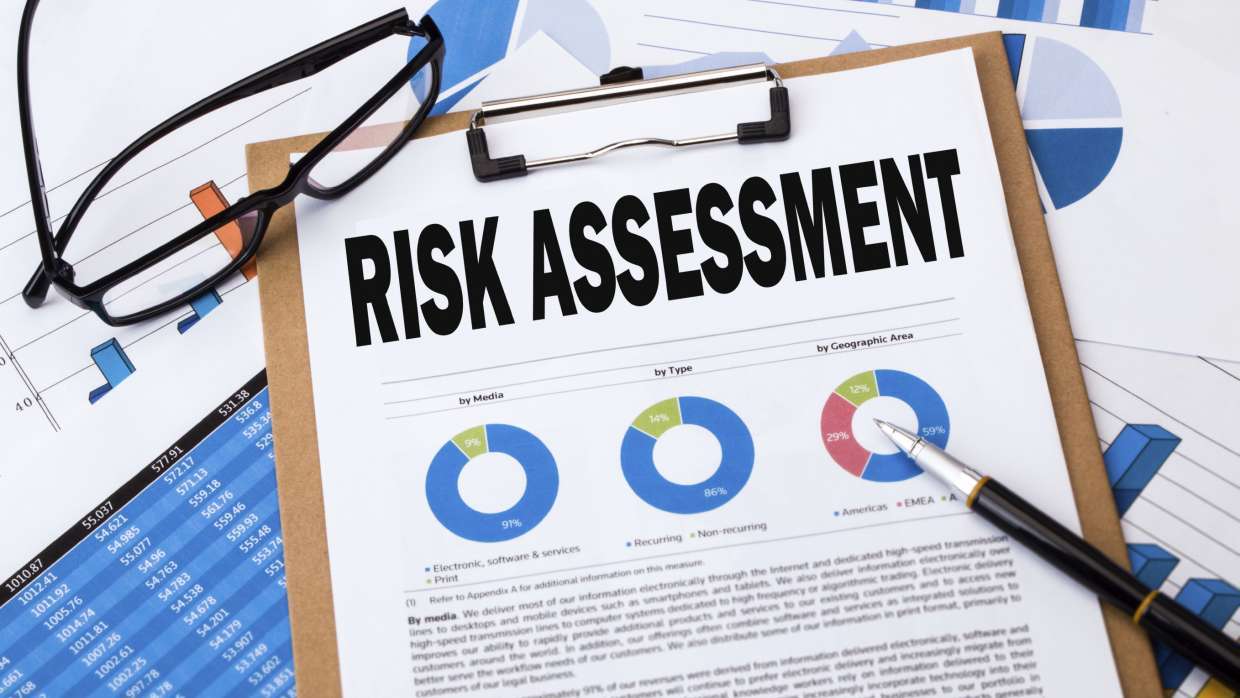Health and Safety Risk Assessments
A risk assessment is simply a careful examination of whatever, in your work or workplace, could cause harm to people, so that you can determine what precautions or controls are necessary to prevent harm. The intention is to prevent accidents or work related ill health in the workplace. The Control Measures that are determined to be necessary to adequately safeguard against accidents or ill-health must be specified in writing. This is the outcome of the risk assessment and it is your duty to ensure that it is fully implemented. In specifying the control measures, the risk assessment provides the practical and detailed roadmap to help you manage health and safety in your workplace.
When thinking about your risk assessment, remember:
A hazard is anything that may cause harm, such as chemicals, electricity, working from ladders, an open drawer etc;
The risk is the chance, high or low, that somebody could be harmed by these and other hazards, together with an indication of how serious the harm could be.
This assessment should:
· Identify the hazards
· Identify all affected by the hazard
· Evaluate the risk
· Identify and prioritise the required actions
No risk assessment will ever be perfect but it should be suitable and sufficient.
The risk assessment needs to show that a proper check was made, the correct people consulted, the results noted, suitable improvements made and that the remaining risk reduced. An action plan is a good way to deal with improvements over a period of time.
You will need to review your risk assessment over a period of time, along with your action plan. If there are significant changes to your workplace or working environment then you will need to update your risk assessment and action
Once the hazards are identified, work out which group of people may be put at risk and identify how they may be harmed, which type of injury or ill health might occur. Some workers have particular requirements, pregnant women, inexperienced workers, cleaners, visitors.
Now that the risks are identified, it has to be decided how to deal with them. The law asks for the majority of risks that you implement risk reduction measures which are “reasonably practicable”.
The process commences with the employer taking reasonable care to identify the risks associated with (but not limited to):
Work premises
Work practices, systems and shift working arrangements (including hazardous processes, psychological and fatigue related hazards)
Plant (including the transport, installation, erection, commissioning, use, repair, maintenance, dismantling, storage or disposal of plant)
Hazardous substances (including the production, handling, use, storage, transport or disposal of hazardous substances)
Presence of asbestos
Manual handling (including potential for occupational overuse injuries)
Layout and condition of the workplace (e.g. lighting and workstation design)
Physical working environment (including the potential for any one or more of electrocution; drowning; fire or explosion; people slipping, tripping or falling; contact with moving objects; exposure to noise, heat, cold, vibration, radiation, static electricity or a contaminated atmosphere)
Potential for workplace violence and biological hazards.
The steps of a risk assessment are as follows:
· Step 1: Identify the hazards
· Step 2: Decide who might be harmed and how
· Step 3: Evaluate the risks and decide on precaution
· Step 4: Record your findings and implement them
· Step 5: Review your assessment and update if necessary
Identify the hazards
First you need to work out how people could be harmed. When you work in a place every day it is easy to overlook some hazards. Here are some tips to help you identify the ones that matter:
Walk around your workplace and look at what could reasonably be expected to cause harm. Ask your employees or their representatives what they think. They may have noticed things that are not immediately obvious to you.
The Public Health Hazardous Substances Act No.15 of 1973 and the Occupational Health and Safety Act Republic of South Africa No.85 of 1993 will give practical guidance on where hazards occur and how to control them. There is much information here on the hazards that might affect your business.
If you are a member of a trade association, contact them. Many produce very helpful guidance.
Check manufacturer's instructions or data sheets for chemicals and equipment as they can be very helpful in spelling out the hazards and putting them in their true perspective.
Have a look back at your accident and ill-health records – these often help to identify the less obvious hazards. Remember to think about long-term hazards to health (e.g. high levels of noise or exposure to harmful substances) as well as safety hazards.
Decide who might be harmed and how
For each hazard, you need to be clear about who might be harmed; it will help you identify the best way of managing the risk. That doesn’t mean listing everyone by name, but rather identifying groups of people (e.g. ‘people working in the storeroom’ or ‘passers-by’).
In each case, identify how they might be harmed, i.e. what type of injury or ill health might occur.
Remember:
Some workers have particular requirements, e.g. new and young workers, new or expectant mothers and people with disabilities may be at particular risk. Extra thought will be needed for some hazards
Cleaners, visitors, contractors, maintenance workers etc, who may not be in the workplace all the time; members of the public, if they could be hurt by your activities; if you share your workplace, you will need to think about how your work affects others present, as well as how their work affects your staff – talk to them; and ask your staff if they can think of anyone you may have missed.
Evaluate the risks and decide on precautions
Having spotted the hazards, you then have to decide what to do about them. The law requires you to do everything ‘reasonably practicable’ to protect people from harm. You can work this out for yourself, but the easiest way is to compare what you are doing with good practice.
So first, look at what you’re already doing; think about what controls you have in place and how the work is organised. Then compare this with the good practice and see if there’s more you should be doing to bring yourself up to standard. In asking yourself this, consider:
Can I get rid of the hazard altogether? If not, how can I control the risks so that harm is unlikely?
When controlling risks, apply the principles below, if possible in the following order:
Try a less risky option (e.g. switch to using a less hazardous chemical);
Prevent access to the hazard (e.g. by guarding);
Organise work to reduce exposure to the hazard (e.g. put barriers between pedestrians and traffic);
Issue personal protective equipment (e.g. clothing, footwear, goggles etc);
Provide welfare facilities (e.g. first aid and washing facilities for removal of contamination).
Record your findings and implement them
Writing down the results of your risk assessment, and sharing them with your staff, encourages you to do this. If you have fewer than five employees you do not have to write anything down, though it is useful so that you can review it at a later date if, for example, something changes.
We do not expect a risk assessment to be perfect, but it must be suitable and sufficient. You need to be able to show that:
A proper check was made; you asked who might be affected;
You dealt with all the significant hazards, taking into account the number of people who could be involved;
The precautions are reasonable, and the remaining risk is low;
You involved your staff or their representatives in the process.
Review your risk assessment and update if necessary
The following information is applicable for the reviewing of your risk assessment:
Few workplaces stay the same. Sooner or later, you will bring in new equipment, substances and procedures that could lead to new hazards. It makes sense, therefore, to review what you are doing on an ongoing basis. Every year or so formally review where you are, to make sure you are still improving, or at least not sliding back.
Look at your risk assessment again. Have there been any changes? Are there improvements you still need to make? Have your workers spotted a problem? Have you learnt anything from accidents or near misses? Make sure your risk assessment stays up to date.
When you are running a business it’s all too easy to forget about reviewing your risk assessment – until something has gone wrong and it’s too late. Why not set a review date for this risk assessment now? Write it down and note it in your diary as an annual event.
During the year, if there is a significant change, don’t wait. Check your risk assessment and, where necessary, amend it. If possible, it is best to think about the risk assessment when you’re planning your change – that way you leave yourself more flexibility.
Hazard Identification, Risk Assessment and Determining Controls
The Managing Director shall ensure that all hazards associated with its activities are assessed for risk so that precautions can be identified and actioned before work commences. The following aspects will be considered for risk assessment from preparation:
· Routine and non-routine activities
· Hazards originating externally to the workplace
· Work operations including contractor activities
· Use of infrastructure, equipment and materials
· Whenever change occurs to systems, processes equipment, personnel, materials etc.
· Changes in legislation
· Emergency situations & potential incidents e.g. fire, accidents
· Contractors and visitors to the workplace
· The capabilities of personnel including human behaviour
There are generic risk assessment forms available to simplify the process and can be adapted to your unique requirements. All risk assessments should be reviewed on a regular basis by a competent consultant to ensure that they are performed adequately. Copies of all assessments must also be given to the health and safety representative.
Unfortunately, hazards cannot always be avoided, and it is imperative that employees know what to do in an emergency.
A Risk Assessment should be suitable and sufficient
11th Oct
Posted date: 11th Oct 2018
Latest News - Risk Assessment - OHS Risk Assessment - Security Industry - Educational Services Industry - Food Drinks and Tobacco Industry - Wood and Upholstery Industry - Printing and Paper Industry - Chemical Rubber Oil and Paint Industry - Iron Steel Artificial Limbs Galvanizing Garages and Metals Industry - Trade and Commerce Industry - Banking and Insurance Industry - Airline Aviation Industry - Road Transport Hauliers Industry - Entertainment and Sport Industry - Professional Services Hospitality Industry - Charitable Religion Political and Trade Organisations Industry - Glass Brick Tiles and Concrete Industry 



Leave a comment